Transcription Automation Server
The Transcription Automation Server is a powerful and versatile component of the 360Converter Transcriber software, designed to seamlessly integrate automatic transcription capabilities into enterprise-level projects and products. This robust server offers multiple integration options to suit various workflow requirements:
- Automated File Processing: Configure the server to automatically transcribe audio and video files added to pre-defined locations, outputting transcripts to specified directories in your desired format.
- API Integration: Develop custom solutions in Python, Go, Java, or other programming languages to interact with the Transcription Automation Server, sending requests and retrieving transcripts programmatically.
- Command-Line Interface: Utilize the provided CLI tools for quick and easy transcription tasks, ideal for scripting and automation.
- Comprehensive Analytics: Gain valuable insights into your transcription processes with our built-in analytics dashboard, offering detailed metrics on usage, performance, and language distribution.
With its flexibility and powerful features, the Transcription Automation Server empowers enterprises to incorporate state-of-the-art transcription capabilities into their existing infrastructure, enhancing productivity and streamlining content processing workflows for both audio and video files.
Server Configuration
Run Server As
Choose from three operational modes:
- Directory Monitor: Automatically process audio and video files placed in a specified folder.
- HTTP Server: Accept transcription requests via HTTP API.
- Command Line Interface: Run the server to accept requests from our dedicated CLI program (otcli).
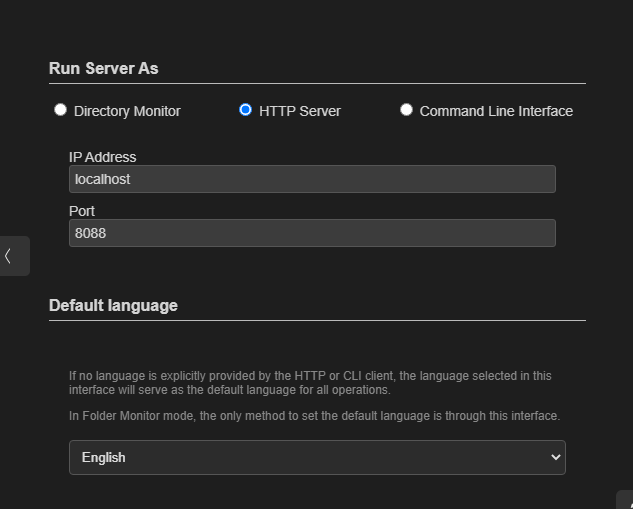
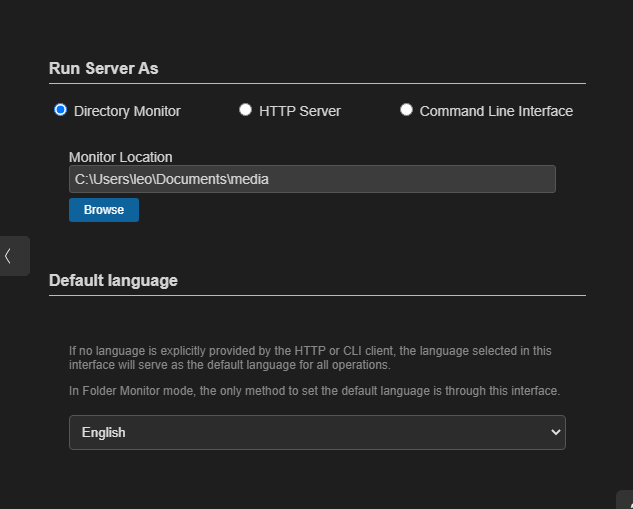
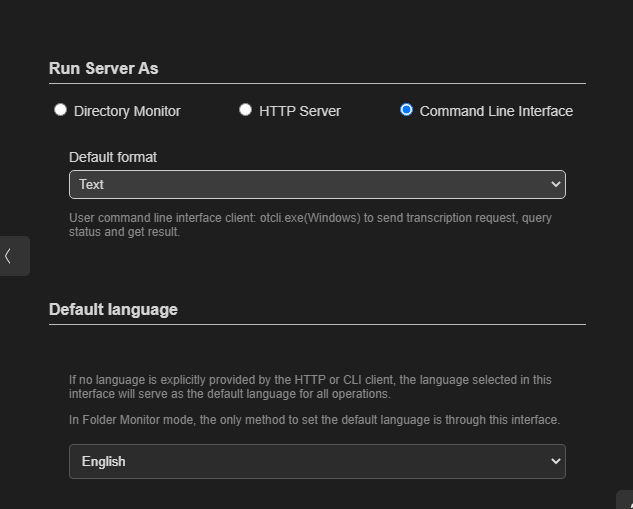
Output Options
- Output Location: Specify where transcription results should be saved.
- Output Format: Choose between Text (.txt), JSON (.json), or Subtitle (.srt) formats.

Notification Settings
- Background Notifications: Enable/disable notifications when the server runs in the background.
- Notification Types:
- Job started
- Job completed
- New request (optional)
Default Language
Select the default language for transcription operations. This setting is particularly important for the Directory Monitor mode, as it's the only place to specify the language for automatic processing. When using other modes, language can be specified per request.
Server Operation
Starting the Server
Click the "Start" button to begin server operation. The view will automatically switch to the console view, regardless of the current view. A flashing green icon will appear in the top-right corner, indicating that the server is running. To stop the server, click the "Stop" button at any time.
Server Console
The console window displays real-time logs of server status and job-related information, including:
- Server start/stop events
- Job processing updates
- Client actions (e.g., query status, fetch results)
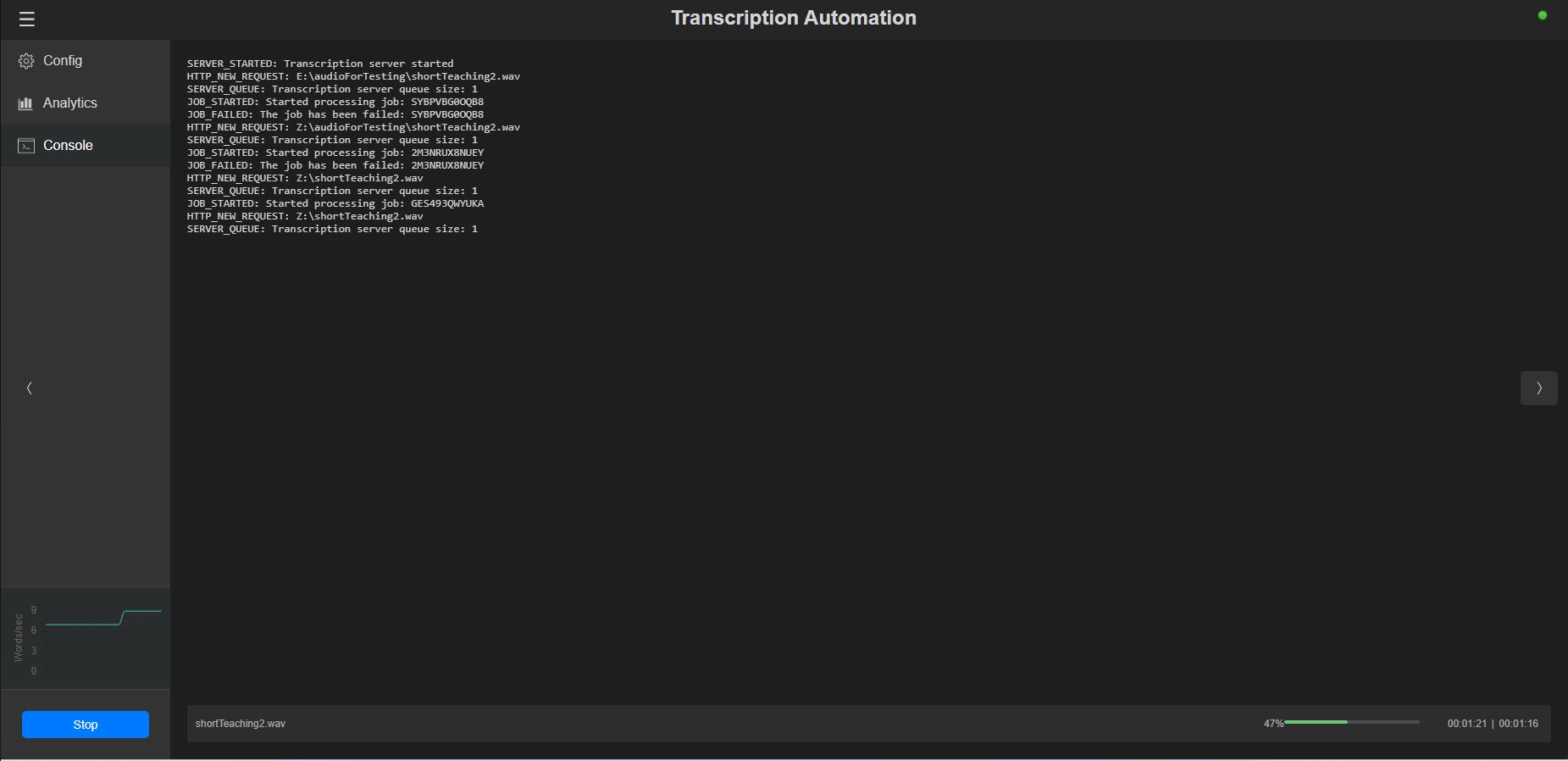
Background Operation
To run the server in the background, click on the menu icon and select "Run in Background". This will minimize the server to the system tray, allowing it to continue operating without occupying your desktop space. The server will continue to operate, and notifications will appear based on your settings.
Notifications for selected events (job started, job completed, new request) will popup at the bottom-right corner of your screen (Windows version), just above the application icon in the system tray.
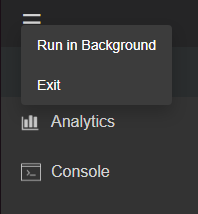
Server Analytics
The analytics dashboard provides comprehensive insights into server usage and performance. You can filter the data and export it for further analysis.
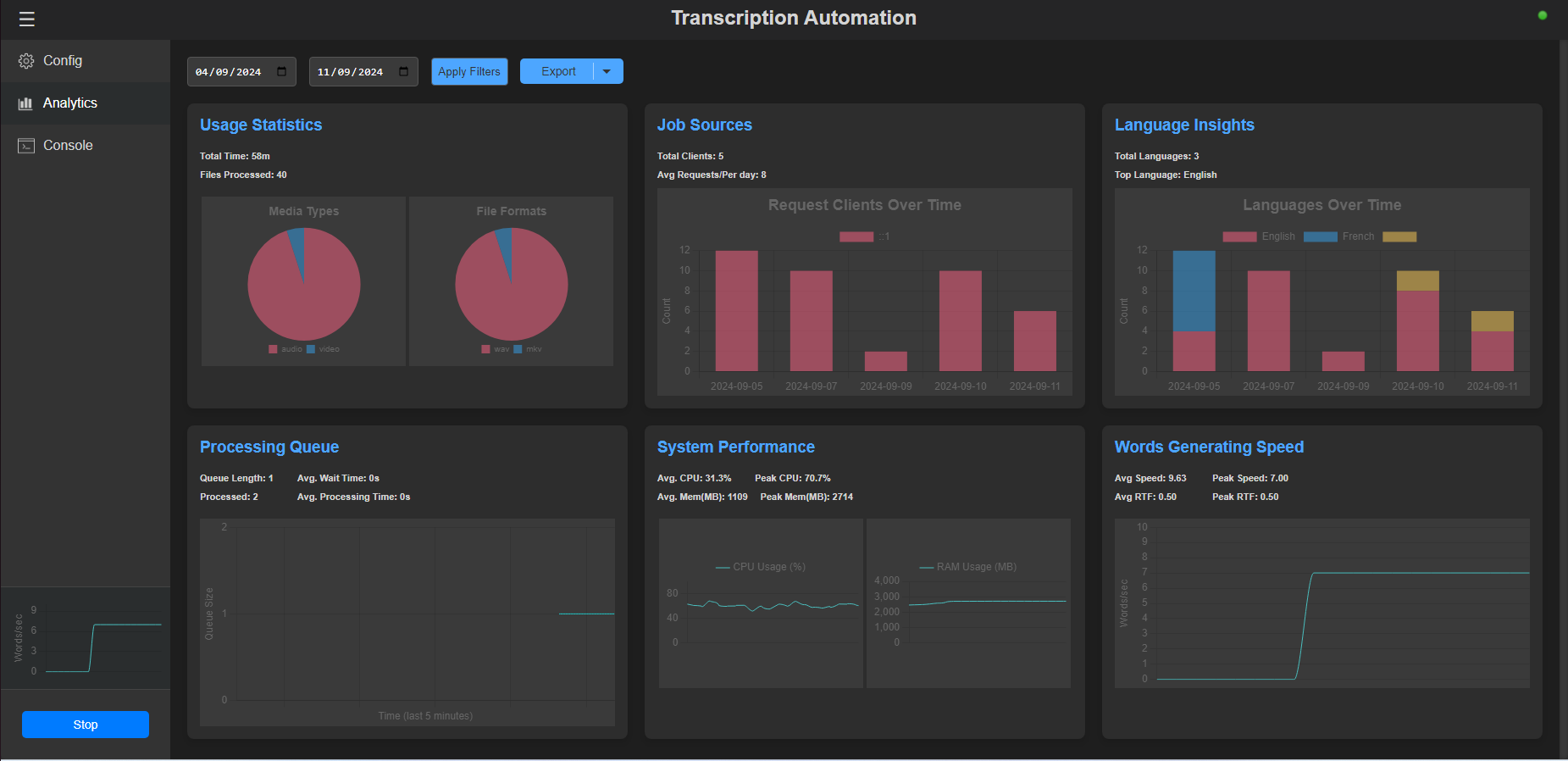
Filtering Analytics Data
Use the date range selectors at the top of the dashboard to filter the analytics data. This allows you to focus on specific time periods for your analysis. Click the "Apply Filters" button to update the dashboard with your selected date range.
Exporting Analytics Data
You can export the analytics data for further analysis or reporting. Click the "Export" button to choose your preferred format:
- CSV (Comma-Separated Values)
- JSON (JavaScript Object Notation)
- XML (eXtensible Markup Language)
The exported data includes information from all four charts in the first row of the dashboard:
- Usage Statistics
- Job Sources
- Language Insights
- Processing Queue

Usage Statistics
- Total Time
- Files Processed
- Media Types (pie chart)
- File Formats (pie chart)
Job Sources
- Total Clients
- Average Requests/Per day
- Request Clients Over Time (bar chart)
Language Insights
- Total Languages
- Top Language
- Languages Over Time (stacked bar chart)
Processing Queue
- Queue Length
- Average Wait Time
- Average Processing Time
System Performance
- CPU Usage (average and peak)
- Memory Usage (average and peak)
Words Generating Speed
- Average Speed
- Peak Speed
- Real-Time Factor (RTF): This metric indicates how fast the transcription is performed compared to the duration of the audio/video. An RTF of 1.0 means the transcription takes exactly as long as the audio/video duration. Lower values indicate faster processing.
HTTP API Endpoints
When running in HTTP Server mode, the following endpoints are available:
1. Submit Transcription Job
POST /transcribe
Content-Type: application/json
{
"url": "C:\\path\\to\\audio\\or\\video\\file.mp3"
}2. Query Job Status
GET /status/{job_id}3. Get Transcription Result
GET /result/{job_id}?format=txt×tamp=false4. Get Supported Languages
GET /languagesCommand Line Interface
The Transcription Client Command Line Interface (CLI) is a powerful tool designed to interact with our transcription service. It allows users to send transcription jobs, monitor their status, and retrieve results efficiently. This guide will walk you through the various functionalities and provide examples of how to use the CLI effectively.
When the server is running in Command Line Interface mode, use the otcli.exe (Windows) client to send transcription requests, query job status, and retrieve results. This dedicated program provides a seamless way to interact with the server through command-line operations.
Transcription Client
For more details on how to interact with these endpoints, please refer to the Transcription Client documentation.
